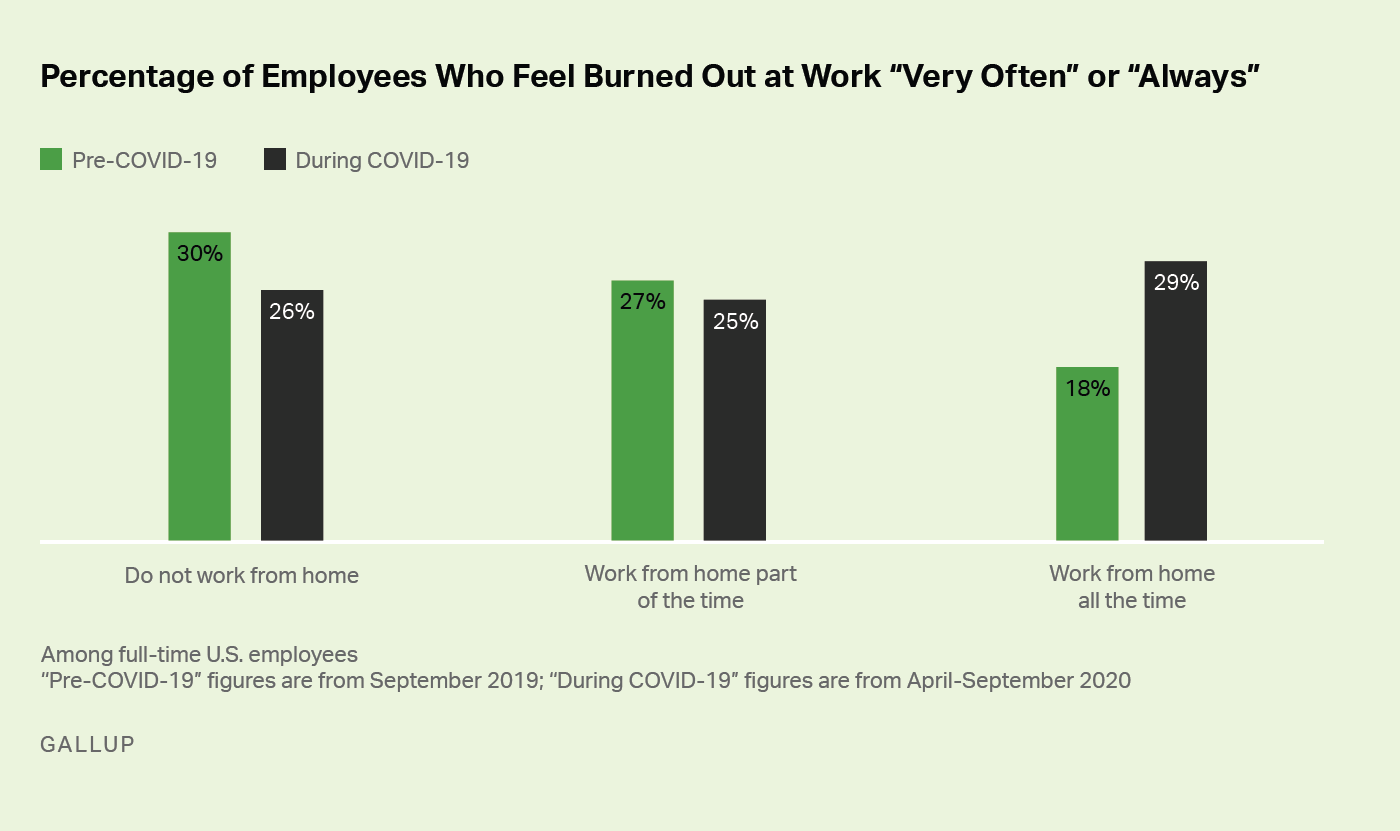Working from home full time during the pandemic is a very different experience than working remotely prior to COVID-19 -- and it shows in our burnout data.
Employee burnout was a rising concern before the pandemic, with the workforce experiencing a significant increase in burnout from 2016 to 2019.
Unsurprisingly, employee burnout levels in 2020 have remained high throughout COVID-19 -- with a major shift that we've never seen before: Fully remote workers are now experiencing more burnout than on-site workers.
Employees who experience high levels of burnout are 63% more likely to take a sick day, 13% less confident in their performance and 23% more likely to visit the emergency room.
Before the pandemic, the perks of working remotely -- either part of the time or all the time -- resulted in lower levels of burnout compared with employees who were on-site 100% of the time.

Line graph. The percentage of full-time employees experience burnout at work always or very often has increase among those who work fully from home, from 18% pre-COVID-19 to 29% during COVID-19. Among those who work from home part of the time, it decreased from 27% to 25%. Among those who do not work from home, it decreased from 30% to 26%.
Before, many employees had the flexibility and autonomy to show up in the office a few days a week or work remotely as needed.
Now, working entirely from home during the pandemic might feel more like being "trapped at home" instead of a perk.
As of September, nearly 40% of full-time employees were working entirely from home (vs. 4% pre-COVID) and under very different circumstances than pre-pandemic remote workers.
Remote work is no longer a choice for many employees who were forced home by health concerns and organizational policies. And this new reality has persisted for more than six months.
That is a jarring shift in how we work -- maybe the biggest shift of the modern era.
Being forced home, practically overnight, created challenges in how people work because they didn't have enough time to prepare. In many organizations, employees were told to grab what they could from their office and head home, not knowing how long they would be there. Some businesses had to acquire laptops and home office resources that they'd never considered providing before.
Uncertainty took hold of the entire workforce, and record levels of daily stress and worry emerged. The emotional trauma from stress and worry has been even higher among remote workers than in-house workers throughout the pandemic due to the challenges of balancing home life and work in the same setting.
Stress is associated with serious health problems -- including heart disease, diabetes and reduced immunity.
Many parents have kids at their feet while they work or are helping them with distance learning for a good part of the day. Many employees feel like the workday never ends as they scramble to shift from home life to work life and back again, trying to keep it all afloat.
And at-home workers, especially those who are not married, are more susceptible to feelings of loneliness and isolation.
This is very different than choosing to work entirely from home pre-COVID -- many people are now trapped in an unprecedented set of new circumstances.
Practice helps -- which gives us hope for improvement over time. Gallup research shows that experienced remote workers are coping with these challenges better than those who are trying to figure out how to get in the rhythm of remote work.
Luckily, even with new challenges at hand, there are opportunities as well.
Currently, although they report feeling more burned out, fully remote workers are more engaged than in-house workers and feel more prepared to do their job amid the pandemic. They save time by avoiding the commute, there are fewer office distractions, they can wear comfy clothes, and they usually have a more flexible schedule.
Even more encouraging are our data that show fully remote workers can have astoundingly high engagement when they have a good manager and organizational communication that helps them feel connected and supported. They thrive when they have clear expectations and receive frequent, meaningful coaching.
The balancing act for managers trying to figure out how to lead their team through the pandemic lies in focusing on performance outcomes while supporting workers' engagement and wellbeing.
Fully remote employees are managing to remain engaged and effective at work during the pandemic while taking on enormous emotional trauma -- higher burnout, stress, worry and loneliness. This puts managers in a challenging position in which they have employees who are highly motivated but pushing them too hard or in the wrong way could sacrifice their already fragile wellbeing.
So, what can leaders do to help?
For employers, it might seem like there's not much you can do for employees stressed out by the pandemic beyond providing a steady paycheck, benefits and an employee assistance program.
But the truth is, stress or worry caused by the outside world is only one component that contributes to burnout.
The top five factors that correlated most highly with employee burnout prior to the COVID-19 pandemic are:
- unfair treatment at work
- unmanageable workload
- unclear communication from managers
- lack of manager support
- unreasonable time pressure
(To see all 15 contributing factors, download our report.)
These five factors are all closely related to how a manager leads their team.
While employee engagement and burnout typically go hand in hand, we're seeing that employees can overcome external challenges and still be interested in and even enthusiastic about their work when their manager learns how to engage them.
Yes, adjustments to how leaders engage their teams will need to be made. They'll have to get creative in how they inspire connectivity and collaboration and develop their employees.
But the fundamental human needs of employees remain the same.
Let's Make Working From Home Feel Like a Perk Again
The typical benefits of working from home -- no office distractions, no commute, more time to do errands and housework -- are at odds with having family members at home during the day and generally having to figure out new ways to get things done.
And those benefits won't ever outweigh having a bad manager.
Just like before the pandemic, work-from-home policies never work out well for employees if their managers aren't truly supportive of and transparent about their specific expectations. When the challenges of remote work transpire into micromanagement or absent managers, that's when things fall apart.
Great managers, unlike bad or even mediocre ones, can significantly improve their team's performance from any location. Great managers can also boost team engagement and keep burnout at bay much more than anything else can.
When managers do their job well, working from home can create new opportunities for increased autonomy, frequent and meaningful conversations, regular recognition, and more intentional employee development.
Where to start? Your managers can mitigate the risk of burnout by focusing on what primarily causes it -- and truly supporting remote employees with individualization, flexibility, and time throughout the day to deal with stress and disruptions and tend to personal wellbeing.
Make sure your managers are funneling important messages from leadership and speaking up about what they expect from employees during this time ... and ensure those expectations take into account the added stress and worry that most of us are experiencing. Now is the time to focus on the whole person, along with their performance expectations and development needs.
As the perks of working from home feel like they're fading and fatigue is setting in, we are likely headed for a tipping point. Leaders can learn how to guide their people through this crisis and sustain their culture -- or let the burnout dam break, dragging down engagement and performance with it.
Working from home could be here to stay for the foreseeable future, but feeling trapped at home doesn't have to.
Lead your remote team away from burnout and toward engagement:
- Download Employee Burnout: Top Causes and Cures.
- Discover the best ways to lead and manage a successful remote workforce.
- Find out what support your managers need and the best kind of learning programs that will help them reduce burnout for their teams.




